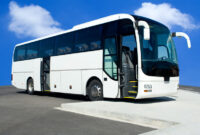Educational trips for seniors offer a unique blend of learning and leisure, allowing older adults to explore new cultures, expand their knowledge, and create lasting memories. These journeys cater to diverse interests and physical abilities, providing enriching experiences tailored to the specific needs and preferences of the senior traveler. From historical explorations to nature immersion, educational trips offer a stimulating alternative to traditional retirement activities, fostering intellectual curiosity and social engagement in a supportive and comfortable environment.
This exploration delves into the planning, logistics, accessibility considerations, and educational content involved in creating successful and fulfilling educational trips for seniors. We’ll examine various trip types, discuss strategies for ensuring inclusivity, and share best practices for marketing and post-trip engagement, drawing on case studies to highlight successful models.
Types of Educational Trips for Seniors
Educational travel offers seniors a unique opportunity to combine learning with leisure, enriching their lives and expanding their horizons. Choosing the right trip depends on individual interests, mobility, and budget. Careful consideration of these factors ensures a safe, enjoyable, and intellectually stimulating experience.
Categorized Educational Travel Options for Seniors
Several categories of educational trips cater specifically to the needs and preferences of seniors. These trips balance enriching experiences with accessibility and comfort.
| Trip Type | Description | Physical Demands | Average Cost Range |
|---|---|---|---|
| Historical Tours | Visits to significant historical sites, museums, and landmarks, often including guided tours and lectures. Examples include exploring ancient Roman ruins in Italy or visiting historical battlefields in the US. | Low to Moderate (depending on the specific sites and accessibility features). Many historical sites offer wheelchair access and other accommodations. | $2,000 – $8,000+ (depending on duration, location, and level of luxury) |
| Cultural Immersion Programs | Immersive experiences focusing on a particular culture, including interaction with locals, participation in traditional activities, and exploration of local arts and crafts. Examples include learning pottery in Tuscany or participating in a cooking class in Mexico. | Low to Moderate (depending on the activities chosen; many programs offer modified activities for seniors). | $3,000 – $10,000+ (depending on the program’s length and location) |
| Nature and Wildlife Tours | Journeys to scenic locations with opportunities for birdwatching, wildlife viewing, and nature walks. These trips often involve comfortable transportation and accessible viewing points. Examples include a cruise to Alaska to see glaciers and wildlife or a safari in Tanzania (with adapted vehicles). | Low to Moderate (depending on the specific activities; many tours offer options for those with limited mobility). | $4,000 – $12,000+ (depending on the location and the level of luxury) |
| Cruise Vacations with Educational Components | Cruises that incorporate lectures, workshops, or shore excursions with educational themes. Examples include a cruise focused on the history of the Mediterranean or a cruise exploring the Galapagos Islands with naturalist guides. | Low (most cruises offer accessible cabins and amenities). | $3,000 – $15,000+ (depending on the cruise line, cabin class, and itinerary). |
| Literary and Art Tours | Trips centered around exploring the works of famous authors or artists, visiting museums, and attending lectures or workshops. Examples include a tour of Shakespeare’s England or a tour of the art museums in Paris. | Low to Moderate (depending on the amount of walking involved). | $2,500 – $9,000+ (depending on the destinations and length of the tour). |
Unique Educational Aspects of Each Trip Type
Each trip type offers unique learning opportunities. Historical tours provide firsthand experience of significant events and places. Cultural immersion programs foster understanding and appreciation of diverse cultures. Nature and wildlife tours enhance awareness of environmental conservation. Cruises with educational components offer a convenient and comfortable way to explore multiple destinations while learning. Literary and art tours deepen appreciation for creative expression and its historical context. The educational value extends beyond the formal lectures and guided tours; the experience itself becomes a learning process, enriching participants’ lives in numerous ways.
Planning and Logistics
Planning a successful educational trip for seniors requires meticulous attention to detail and careful consideration of the unique needs and preferences of this age group. This involves a multi-faceted approach encompassing budgeting, transportation, accommodation, and group dynamics. Thorough preparation ensures a safe, enriching, and enjoyable experience for all participants.
Budgeting for Senior Educational Trips
Creating a comprehensive budget is crucial for managing the financial aspects of the trip. This involves estimating costs associated with transportation (flights, buses, local transport), accommodation (hotels, senior-friendly facilities), entrance fees to attractions, meals, activities, and potential unforeseen expenses. It is advisable to include a contingency fund of at least 10-15% of the total estimated cost to cover any unexpected situations, such as medical emergencies or itinerary changes. For example, a 10-day trip for a group of 10 seniors might have a base budget of $10,000, with a contingency fund of $1,000-$1,500. Detailed cost breakdowns should be provided to participants well in advance.
Transportation Considerations for Seniors
Transportation needs to be comfortable and safe for senior travelers. Consider the physical limitations of the group when choosing modes of transport. Options such as comfortable motor coaches with restroom facilities are ideal for longer distances, minimizing fatigue. Within destinations, accessible local transport, such as taxis or readily available public transport with ramps and elevators, should be prioritized. Booking transportation in advance is essential to secure availability and potentially negotiate group discounts. Pre-arranged airport transfers are also recommended to minimize stress upon arrival and departure.
Accommodation for Senior Travelers
Choosing suitable accommodation is paramount. Senior-friendly hotels or resorts offering accessible rooms with features like grab bars, roll-in showers, and elevators are preferred. Proximity to attractions and amenities is also a key consideration, minimizing the need for extensive travel and potential fatigue. Consider booking rooms on lower floors to avoid excessive stair climbing. It is also important to check the hotel’s policies on accessibility and assistance for seniors, such as availability of wheelchairs or other mobility aids. For example, a hotel that offers accessible rooms and a dedicated concierge service for seniors could be ideal.
Group Size and Travel Companions
The ideal group size for a senior educational trip depends on various factors, including the participants’ mobility levels, the complexity of the itinerary, and the desired level of interaction. Smaller groups (8-12 people) generally allow for more personalized attention and flexibility, while larger groups may require more logistical coordination. Careful consideration should be given to the compatibility of group members, ensuring a mix of personalities and interests that promotes a harmonious travel experience. Travel companions can be friends, family members, or individuals with shared interests, making the experience more enjoyable and supportive. A designated trip leader or coordinator can also help manage the group’s needs.
Checklist for Senior Educational Trips
Before embarking on the trip, a comprehensive checklist should be prepared. This includes ensuring all participants have valid passports or identification documents, necessary travel insurance, copies of medical records and emergency contact information, any prescribed medications, comfortable clothing and footwear appropriate for the climate and planned activities, and sufficient funds. Confirming flight or train reservations, hotel bookings, and any pre-booked tours or activities is also crucial. Finally, reviewing the itinerary with participants and addressing any questions or concerns ensures a smooth and enjoyable trip.
Accessibility and Inclusivity
Ensuring all seniors can participate fully and comfortably in educational travel is paramount. This requires proactive planning and a commitment to inclusivity, addressing diverse physical, cognitive, and sensory needs. A successful trip hinges on anticipating potential challenges and implementing strategies to mitigate them, fostering a welcoming and supportive environment for every participant.
Strategies for Ensuring Accessible and Inclusive Educational Trips for Seniors
Accessibility Features and Accommodations
Providing accessible travel options is crucial. This includes selecting transportation with wheelchair accessibility (e.g., buses with ramps and lifts, accessible train carriages), choosing hotels with accessible rooms featuring features like roll-in showers, grab bars, and lowered countertops, and ensuring that all tour locations are wheelchair accessible or offer alternative access routes. Pre-trip site visits can help identify and address potential accessibility issues before the trip commences. Consider using a travel agent specializing in accessible travel for assistance.
Managing Medical Emergencies and Health Concerns
Thorough pre-trip health assessments are essential. This involves collecting detailed information on participants’ medical history, current medications, and any specific needs or concerns. Establishing clear communication channels with medical professionals, including having a designated point of contact readily available, is critical. Emergency contact information should be widely distributed and readily accessible to all participants and trip leaders. A well-defined emergency response plan, including procedures for contacting emergency services and transporting individuals to medical facilities, should be in place and communicated clearly to all involved. First-aid kits should be adequately stocked and accessible, with at least one trained first-aider present on the trip.
Resources for Accessible Travel Options and Accommodations
Several resources exist to assist in planning accessible trips. Organizations specializing in accessible travel often provide detailed information on accessible accommodations, transportation options, and tour destinations. Websites and travel guides dedicated to accessible travel offer reviews and ratings of accessible locations. Government tourism websites often provide information on accessibility standards and regulations within a specific region. For example, many countries have accessibility websites dedicated to providing information on accessible transportation, accommodations, and attractions. Additionally, online review sites often include accessibility information provided by past travelers.
Post-Trip Engagement
Maintaining engagement with participants after an educational trip is crucial for maximizing the long-term impact of the experience. A well-planned post-trip strategy fosters continued learning, strengthens social bonds formed during the trip, and provides valuable feedback for future improvements. This involves a multi-faceted approach encompassing communication, community building, and feedback collection.
The primary goal is to ensure the trip’s positive impact extends beyond the travel dates. This can be achieved through various methods that nurture participants’ enthusiasm and facilitate ongoing connections.
Post-Trip Communication Strategies
Effective communication is paramount to maintaining post-trip engagement. This includes promptly sharing high-quality photographs and videos from the trip, ideally within a week of the participants’ return. A curated online album or a slideshow presentation shared via email can effectively reignite positive memories and encourage further discussion. Furthermore, a dedicated email newsletter or social media group can be established to facilitate ongoing communication and share related articles, videos, or upcoming events. This could include links to relevant museums, documentaries, or online courses that expand on the trip’s themes. For instance, if the trip focused on historical sites in Europe, the newsletter might include links to virtual museum tours or documentaries on related historical periods.
Post-Trip Survey Design
A well-designed post-trip survey is an invaluable tool for gathering feedback and enhancing future trips. The survey should be concise and easy to complete, ideally within 5-7 minutes. Open-ended questions, alongside multiple-choice options, provide a balanced approach to gathering both quantitative and qualitative data. For example, the survey could include multiple-choice questions about the trip’s organization, accommodation, and overall satisfaction, followed by open-ended questions such as “What was your favorite aspect of the trip?” and “What suggestions do you have for improving future trips?”. The data collected can be analyzed to identify areas of strength and areas needing improvement, directly influencing planning for subsequent trips. Analyzing participant responses will highlight trends and preferences that can inform decisions regarding future destinations, activities, and logistical arrangements.
Fostering Post-Trip Community
Building and maintaining a sense of community amongst participants post-trip can be achieved through several strategies. Creating a dedicated online forum or social media group allows participants to continue sharing experiences, photos, and memories. Organizing virtual reunions or online discussions can provide opportunities for continued interaction and knowledge sharing. For example, a virtual book club focused on a topic related to the trip or an online Q&A session with a relevant expert can encourage continued engagement and learning. These activities foster a sense of shared identity and encourage ongoing connections among participants long after the trip has concluded. This ongoing interaction can transform a once-off travel experience into a lasting bond between participants.
Conclusion
Ultimately, educational trips for seniors represent a valuable opportunity to enrich lives, promote lifelong learning, and foster a vibrant sense of community. By carefully considering the needs and interests of senior travelers, and by implementing thoughtful planning and inclusive strategies, we can create unforgettable experiences that empower older adults to continue learning, exploring, and connecting with the world around them. The benefits extend beyond the trip itself, fostering lasting personal growth and social engagement long after the journey concludes.



